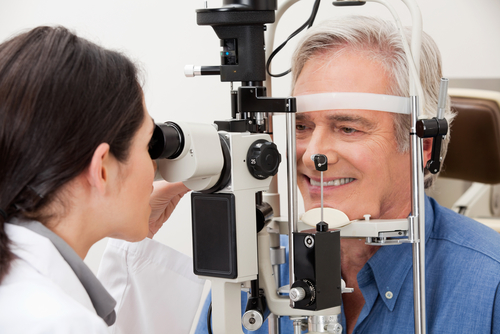Posted by: Eye Health Northwest in Eye Exams, Uncategorized on August 16, 2023

An annual eye exam is the best way to protect your sight. Many vision problems that are caught early can be treated, avoiding more serious damage later on.
Early detection is always the best form of defense against disease. This is why your eye doctor does such a thorough and comprehensive eye exam at each visit.
Keep reading to learn what eye doctors test for during your annual eye exam!
What Happens During an Eye Exam?
There are many important tests that happen as a part of an annual eye exam. They are performed to either gauge the clarity of your vision or detect possible eye conditions.
Some of the most important tests during an eye exam are:
Visual Acuity Testing
This is the test that most people think of as the eye chart test. A standardized chart called a Snellen chart is used at a distance several feet away.
Visual acuity is usually determined in two ways:
- Uncorrected, meaning that you’ll view the chart without glasses or contacts.
- Best corrected, meaning with the best possible glasses or contact lens prescription.
During the visual acuity test, you’ll cover one eye and read aloud the smallest line of letters you can make out on the chart. At the top of the chart, the size of the letters will be easy to read.
As you progress, they grow smaller and get more challenging to read. After one eye is tested, that eye is covered so the other eye can be tested.
This will test your distance vision. You may also be asked to read letters or numbers from a chart held close to your face to test your near vision.
Refraction
For this test, your eye doctor will place a device called a phoropter in front of you, which allows them to place lenses of different strengths in front of your eyes. You’ll look through the lenses and determine which strength lens makes it easiest to read the chart.
The refraction test helps your eye doctor determine the best glasses or contact lens prescription for you.
Slit Lamp Examination
Using a special magnifying device called a slit lamp, your eye doctor will examine the front part of the eye, including your eyelids, cornea, conjunctiva, sclera, and iris. With this test, they can look for any abnormalities.
Eye Pressure Testing
This is also called tonometry. Higher than normal eye pressure is often an indicator of glaucoma, a serious condition that requires treatment.
This test is essential to ensure your eye pressure is within the normal range.
Comprehensive Eye Test
Various other tests can help your eye doctor spot early vision problems. Your eye doctor may also test your peripheral vision and your eye muscles.
Using a penlight or other small object, your eye doctor will ask you to follow the light to see if you can look in different directions, which will indicate the functioning of your eye muscles. The penlight is also used to examine your pupils to see if they constrict in response to light.
Eye drops will also be given to you to dilate your pupils so your eye doctor can look at the back of the eye where the retina is. The retina, nearby blood vessels, and optic nerve will be examined.
Always Share Information and Voice Concerns
When you see your eye doctor, be sure to share information about your family health history, any concerns or problems you may be experiencing, and any other chronic conditions you may have. Certain medications put you at higher risk of developing certain eye conditions.
By being open about your overall health, you can help your eye doctor preserve and maintain your good vision.
Is it time for you to have an eye exam? Schedule an appointment at EyeHealth Northwest in Portland, Oregon, today!

